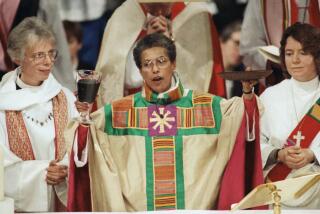Vatican starts women’s study
- Share via
The Vatican has begun a first-ever comprehensive study of women’s religious orders in the United States, four decades into a steep decline in the number of Roman Catholic sisters and nuns in the country.
The study, ordered by a Vatican congregation in December and announced Friday in Washington, will examine “the quality of the life” of 59,000 members in more than 400 Catholic women’s religious institutes, said Sister Eva-Maria Ackerman, a spokeswoman for the study, which is called an apostolic visitation.
“The study is really to encourage the communities, to strengthen them, to help them grow in their vitality,” she said, adding that “women’s religious communities have played such a significant part in building up the church and society in this country.”
The Vatican released results of a similar canvass of U.S. seminaries this month in light of the clergy sexual abuse crisis. That review gave special attention to chastity and celibacy, and the Vatican found that seminaries had largely been successful in rooting out “homosexual behavior.”
The reasoning behind the Vatican’s focus on women’s religious orders is less clear. studyA website on the said the church wanted “to safeguard and promote consecrated life in the United States.”
It also said “many new congregations have emerged in the United States, while many others have decreased in membership or have an increased median age.”
The number of Catholic sisters in the U.S. declined from 173,865 in 1965 to 79,876 in 2000, according to Georgetown University’s Center for Applied Research in the Apostolate. The average age of a member of a women’s religious community was between 65 and 70 in 1999, the center says.
“The numbers tell you everything one needs to know why they’re undertaking an effort like this,” said Russell Shaw, a former spokesman for the U.S. Conference of Catholic Bishops who called the church’s interest “very late in the game.”
“For many of these communities, the handwriting is on the wall. They’re disappearing,” he said.
Historically, Catholic sisters concentrated on teaching and healthcare. Since the modernizing reforms of the Second Vatican Council of the 1960s, many sisters have become activists of social causes, such as protesting nuclear weapons and marching with migrant farmworkers. Some also advocate for women to be ordained as priests or challenge church teaching against abortion rights or gay marriage.
In recent years, newly formed traditional orders -- whose members dress in habits, show fidelity to Rome and focus on education, healthcare and social work -- have reported growth. More established orders that tend to take more progressive social stances have seen their numbers of vocations dwindle.
“The Vatican may be asking the question, ‘Why is this happening, and is there something these more traditional orders offer that the more progressive orders can learn from?’ ” said the Rev. Jim Martin, editor of the Jesuit magazine America.
The Leadership Conference of Women Religious, the nation’s largest association of Catholic female religious communities, said it was informed of the study in a bulletin Friday.
“We hope that the results of the apostolic visitation will demonstrate the vitality and depth of the life and service of women religious in the United States,” the conference said in a statement.
The study, expected to be completed by 2011, will be limited to women’s religious communities doing work in the church and society and will exclude cloistered and contemplative orders.
More to Read
Sign up for Essential California
The most important California stories and recommendations in your inbox every morning.
You may occasionally receive promotional content from the Los Angeles Times.










